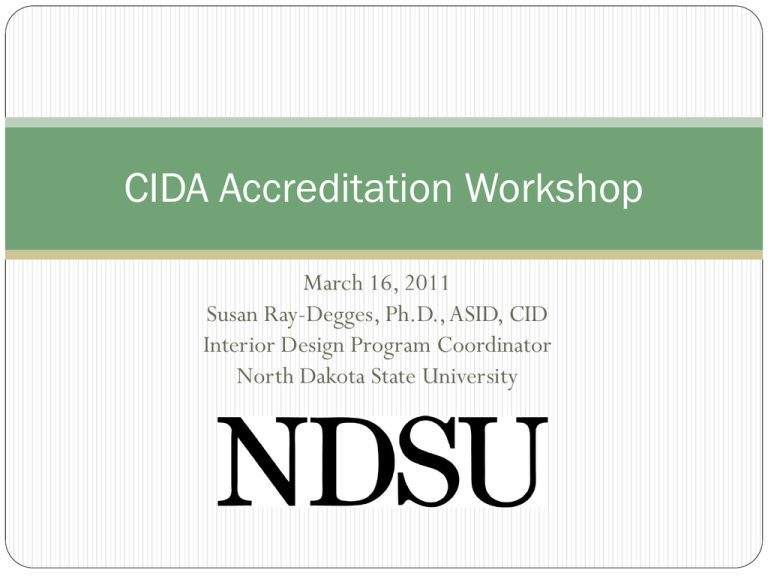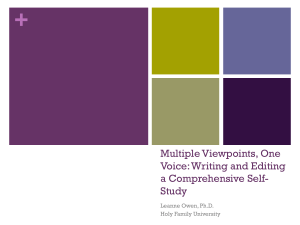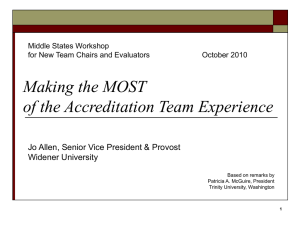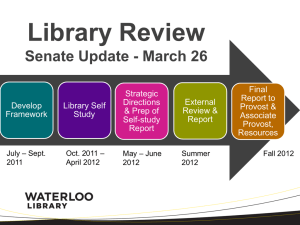Assessment - Council for Interior Design Accreditation
advertisement

CIDA Accreditation Workshop March 16, 2011 Susan Ray-Degges, Ph.D., ASID, CID Interior Design Program Coordinator North Dakota State University Minute Paper Can you list items you think will be covered in the “self-study process” presentation? Setting the Stage Why are we doing this? What do we get out of the process? Getting Everyone On Board Closing the Loop and Getting Everyone On Board…Faculty Buy-In Making self-study meaningful without “overkill”… University Assessment Program Self-Study for Accreditation Yearly reports Site Visit every 6 years Assessment of every class Identification of projects that on a three-year rotation Sophomore/Senior Portfolio Review Internship Review General Education Course Review meet accreditation standards/program outcomes Maintenance of student project archives Retain all elements of a course for archives End of Semester/Year course review Program Self-Study Standard 1. Mission, Goals, and Curriculum The interior design program has a Mission statement that describes the scope and purpose of the program. Program goals are derived from the Mission statement and the curriculum is structured to achieve these goals. Setting the Mission to evaluate the success of meeting specified program outcomes and current CIDA Standards. In preparation of the ID program’s Fall 2009 CIDA Site Visit, all program faculty participated in bi-weekly ID program meetings over the last two academic years (2007/2008; 2008/2009) to to reflect present and future program direction and outcomes, and 2009 CIDA Standards. The following Mission statement was approved in December of 2008……. Setting the Mission Program Mission. Optimizing human potential (of individuals, families, and communities) in the built environment through the application of sustainable and universal design standards, global awareness and diversity, ethical judgment, and technical proficiency. (approved by the ID Faculty, December 2008) Setting our Program’s Outcomes ID program outcomes evolved from this discussion, resulting in three broad educational outcomes that demonstrate an integrated program. Outcome 1: Educate students though an integrated comprehensive study of the theoretical and practical concepts of interior design, building systems, and interior components and construction. Setting our Program’s Outcomes Outcome 2: Develop student ability to synthesize and effectively communicate information, develop critical thinking skills, and initiate lifelong learning skills. Setting our Program’s Outcomes Outcome 3: Instill in students the desire to practice professional ethics to create socially responsible design solutions. Program Outcomes – Tangible Results of Student Performance Evidence of learning revealed in student performance… included…. Student interviews & presentations Employer/Peer/Client/Self - evaluations Completed Student Work Matrixes Bubble diagrams/schematics Drafting, construction documents Research papers Design programming/proposals Presentation materials “Big Picture” Successfully Preparing for the Self-Study Process Reviewing across the curriculum & across a period of time Assessment Instruments Assessment for Learning & Accountability The assessment instruments are designed to measure the curriculum’s success, based on program outcomes and CIDA standards. A diagram is provided below to demonstrate the process the program has developed and effectively implemented. Assessment for Learning The Dual Purposes of Assessment Rubrics Assessment for Accountability (Student, Faculty) CIDA Standards Self-Assessment (Student) Peer Assessment (Classmates, Faculty, Employers, Clients) Sophomore Portfolios (Faculty) Senior Comprehensive Project (Faculty, Professionals) Assessment for Learning & Accountability Outside Review & Feedback Clients, Service Organizations, Employers, Professionals • Freshman-Level Courses • (Self/Peer Assessment) Freshman Sophomore • Sophomore-Level Courses • (Self/Peer/ Sophomore Review) • Junior-Level Courses • (Self/Peer/Internship) • Senior-Level Courses • (Self/Peer/Professionals/Seni or Review) Junior/Senior Assessment for Learning & Accountability As the program evolved to address new challenges experienced in the profession and the 2009 CIDA Standards, course work had been assessed at all levels of the program using different assessment tools. Faculty felt that the assessment results in previous years indicated the need for greater consistency in project evaluations and assessment tools to improve student understanding in the evaluation and assessment process used to measure the effectiveness of curriculum objectives and outcomes ultimately program outcomes Lessons Learned Preparing and Completing the Self-Study Process What did we learn & do? A primary goal during the 2008/2009 academic year was to develop a single assessment rubric that could be shared across the curriculum to better document student learning. After many revisions/rewrites, the faculty approved a single rubric for assessing each course (Freshman Senior) more closely aligned with the 2009 CIDA Standards. It is important to note that sections of the assessment rubric may not be assessed in a given class, depending on the courses outcomes. Section II - Interior Design: Critical Thinking, Professional Values, and Processes Standard 2. Global Context for Design Entry-level interior designers have a global view and weigh design decisions within the parameters of ecological, socio-economic, and cultural contexts. Student Learning Expectations Student work demonstrates understanding of: a) the concepts, principles, and theories of sustainability as they pertain to building methods, materials, systems, and occupants. Students understand: b) globalization and the implications of conducting the practice of design within a world market. c) how design needs may vary for different socio-economic populations. Program Expectations The interior design program provides: d) exposure to contemporary issues1 affecting interior design. e) exposure to a variety of business, organizational, and familial structures. 2 f) opportunities for developing knowledge of other cultures. 3 2009 Standards Example of Assessing A Standard Evaluation Criteria Level 5 Level 4 Level 3 Level 2 Level 1 Global Context for Design: (Standard 2a) Interior designers need to have a global view and weigh design decisions within the parameters of ecological, socio-economic, and cultural contexts Any Value Varies depending on project/assignment criteria The concepts, principles, and theories of sustainability as they pertain to building methods, materials, systems, and occupants has been thoroughly applied throughout the project with great ingenuity The concepts, principles, and theories of sustainability as they pertain to building methods, materials, systems, and occupants has been applied throughout the project The concepts, principles, and theories of sustainability as they pertain to building methods, materials, systems, and occupants has been considered and somewhat applied throughout the project The concepts, principles, and theories of sustainability as they pertain to building methods, materials, systems, and occupants has been considered but minimally applied throughout the project The concepts, principles, and theories of sustainability as they pertain to building methods, materials, systems, and occupants has not been applied throughout the project Additional columns provide areas for faculty/peer/self evaluation rankings comments Now it’s your turn! Think of a project/assignment that you could apply this to What did we learn? Through the use of assessment rubrics the self-assessment process allowed faculty to see a clearer pattern of student understanding across the curriculum and newly implemented 2009 Standards. In some instances students have requested rubrics for specific assignments so that they may better understand what they are completing and why it plays a role in their educational development. CIDA Standard Challenges During the self-study and assessment processes there were two areas the faculty struggled to assess and clearly define. The faculty did not feel Standard 2 – Global Context for Design was clearly defined or that any assessment technique could adequately capture lifelong learning as required by the “Program Expectation (Standard 7-i)” for Standard 7 – Professionalism and Business Practice. Standard 2. Global Context for Design - Entry-level interior designers have a global view and weigh design decisions within the parameters of ecological, socio-economic, and cultural contexts. Standard 7. Professionalism and Business Practice - Entry-level interior designers use ethical and accepted standards of practice, are committed to professional development and the industry, and understand the value of their contribution to the built environment. Program Expectations - The interior design program provides exposure to the role and value of: i) life-long learning. To best capture data for measuring lifelong learning, program alumni will be contacted in the future to identify “lifelong” learning through established professional credentialing including job rank/title, advanced degree, certification, and licensure. Concluding Remarks Data collected from these assessment instruments and the self-study process: Allow faculty to see student areas of weakness that need to be addressed in upcoming semester. Hold faculty members accountable for various areas of content he or she is responsible for teaching. Permit the faculty to adjust and make changes course materials to insure that the students leave with an integrated and timely educational experience. Creates an opportunity for the program to consistently review how well CIDA Standards are being addressed. Concluding Remarks. One of the greatest benefits the combined self-study and assessment process has provided the program is the opportunity to track trends across several academic years and to compare student growth/learning as cohort groups move through program. Questions? Manage your time, be explicit and open, and be willing to start over if it doesn’t work! “Final Assessment” 1. What is the most important point you learned today? 2. What point remains unclear? Additional questions? Contact me by email at Susan.ray-degges@ndsu.edu











